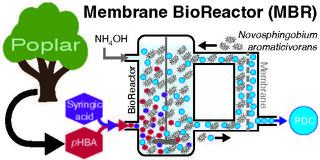Strategies to improve bioreactor productivity of PDC from aqueous aromatic streams

Background/Objective
Aromatic compounds obtained from plant biomass can be used as substrates for microbial production of dicarboxylic acids such as 2-pyrone-4,6-dicarboxylic acid (PDC) and cis,cis-muconic acid, building blocks of plastics and other polymer-based fibers traditionally produced from fossil fuels. This study investigated ways to increase PDC productivity from aqueous aromatic streams.
Approach
Researchers evaluated continuous production of PDC from aqueous aromatic solutions by an engineered strain of the bacterium Novosphingobium aromaticivorans using a flow-through membrane bioreactor (MBR) system to create high-density cultures.
Results
High productivity was achieved from p-hydroxybenzoic acid (pHBA) and syringic acid in experiments using synthetic media and from aromatics derived from the alkaline pretreatment of poplar biomass. High aromatic loading rates, hollow-fiber membranes, and NH4OH for pH control contributed to the highest PDC productivities reported to date. Results revealed a trade-off between maximizing high productivity or product titer in the MBR system.
Impact
Biochemicals from lignocellulosic biomass can decrease dependence on fossil fuels. These findings demonstrate strategies that can be used to increase bioreactor productivity when aromatic substrates are delivered in aqueous form and may provide useful insight for production of other biochemicals from aromatic streams using microbial chasses.